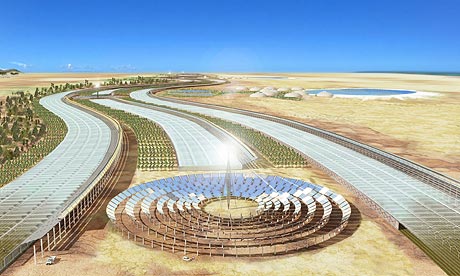The Sahara Forest Project
Posted by Big Gav in africa, agriculture, concentrating solar power, csp, desalination, sahara, solar power, solar thermal
I've posted plenty of stories about solar thermal power in the Sahara, a scheme long ago dubbed deserts of gold, with most of them talking about large scale CSP plants in North Africa supplying clean energy to Europe. The Guardian has a new twist on this vision, with desert CSP plants being twinned with "seawater greenhouses" that grow crops using desalinated water produced using waste heat from the power plant - Environment: Solar plant yields water and crops from the desert.
Vast greenhouses that use sea water for crop cultivation could be combined with solar power plants to provide food, fresh water and clean energy in deserts, under an ambitious proposal from a team of architects and engineers.
The Sahara Forest Project, which is already running demonstration plants in Tenerife, Oman and the United Arab Emirates, envisages huge greenhouses with concentrated solar power (CSP), a technology that uses mirrors to focus the sun's rays, creating steam to drive turbines to generate electricity.
The installations would turn deserts into lush patches of vegetation, according to its designers, and do away with the need to dig wells for fresh water, an activity that has depleted aquifers across the world.
Charlie Paton, a member of the team, and the inventor of the Seawater Greenhouse, said the scheme was a proven way to transform arid environments. "Plants need light for growth but they don't like heat beyond a certain point," he said.
Above certain temperatures the amount of water lost through leaves' stomata rises so much plants stop their photosynthesis and do not grow. The solar farm planned by the project runs seawater evaporators, pumping damp, cool air through the greenhouses. This reduces the warmth inside by about 15C, compared with the temperature outside.
At the other end of the greenhouse from the evaporators, water vapour is condensed. Some of this fresh water is used to water the crops, some for cleaning the solar mirrors.
"So we've got conditions in the greenhouse of high humidity and lower temperature," said Paton. "The crops sitting in this slightly steamy, humid condition can grow fantastically well."
The designers said that virtually any vegetables could be grown in the greenhouses. The demonstration plants already produce lettuces, peppers, cucumbers and tomatoes. The nutrients to grow the plants could come from local seaweed or be extracted from the seawater.
Michael Pawlyn, of Exploration Architecture, based in London, worked on the Eden Project for seven years and is now part of the Sahara Forest team. He said that the Seawater Greenhouse and CSP provided substantial synergies for each other. "Both technologies work extremely well in hot, dry, desert locations. CSP produces a lot of waste heat and we'd be able to use that to evaporate more seawater from the greenhouse. And CSP needs a supply of clean, de-mineralised water in order for the [electricity generating] turbines to function and to keep the mirrors at peak output. It just so happens the Seawater Greenhouse produces large quantities of this."
Paton said the greenhouse produced more than five times the fresh water needed to water the plants inside, so some of the water could be released to the outside, creating a microclimate for hardier plants such as jatropha, a crop that can be turned into biofuel.
The cost of the Sahara Forest Project could be relatively low as both CSP and Seawater Greenhouses are proven technologies. The designers estimate that building 20 hectares (nearly 50 acres) of greenhouses combined with a 10MW CSP scheme would cost about €80m (£65m).
Paton said groups in countries across the Middle East, including in UAE, Oman, Bahrain, Qatar and Kuwait, have expressed interest in possibly funding demonstration projects.
He said use of Seawater Greenhouses could reverse the environmental damage done by the glasshouses already built in places such as the desert region of Almeria, southern Spain, where, constructed over the past 20 years to grow salad crops, they now covered more than 40,000 hectares.
Paton said: "They take water out of the ground something like five times faster than it comes in, so the water table drops and becomes more saline. The whole of Spain is being sucked dry. If one were to convert them all to the Seawater Greenhouse concept it would turn an unsustainable solution into a more sustainable one."
Pawlyn said: "In places like Oman they've effectively sterilised large areas of land by using groundwater that's become increasingly saline. The beauty of the Sahara Forest scheme is that you can reverse that process and turn barren land into biologically productive land."
Neil Crumpton, an energy specialist at Friends of the Earth, said the potential of these desert technologies was huge. "Concentrated solar power mirror arrays covering just 1% of the Earth's deserts could supply a fifth of all current global energy consumption. And 1 million tonnes of sea water could be evaporated every day from just 20,000ha of greenhouses."
Governments should invest in the technologies and "not be distracted by lobbyists promoting dangerous nuclear power or nuclear-powered desalination schemes", Crumpton added.
The International Energy Agency estimates that the world needs to invest more than $45 trillion (£22.5 trillion) in new energy systems over the next 30 years.






